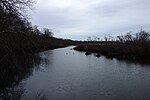Robert Hawkins Homestead
1855 establishments in New York (state)Houses completed in 1855Houses in Suffolk County, New YorkHouses on the National Register of Historic Places in New York (state)Italianate architecture in New York (state) ... and 2 more
National Register of Historic Places in Suffolk County, New YorkSuffolk County, New York Registered Historic Place stubs

Robert Hawkins Homestead is a historic home located at Yaphank in Suffolk County, New York. It was built about 1855 and is a clapboard-sheathed, wood-frame building on a brick foundation. It has a symmetrical, two-story, three-bay, cruciform plan with low intersecting gable roofs in the Italianate style. It features a one-story verandah and a large central cupola on the building's rooftop.It was added to the National Register of Historic Places in 1986, and is directly across the street from the Homan-Gerard House and Mills.
Excerpt from the Wikipedia article Robert Hawkins Homestead (License: CC BY-SA 3.0, Authors, Images).Robert Hawkins Homestead
Glover Drive,
Geographical coordinates (GPS) Address Nearby Places Show on map
Geographical coordinates (GPS)
| Latitude | Longitude |
|---|---|
| N 40.817777777778 ° | E -72.917777777778 ° |
Address
Glover Drive
Glover Drive
11980
New York, United States
Open on Google Maps









